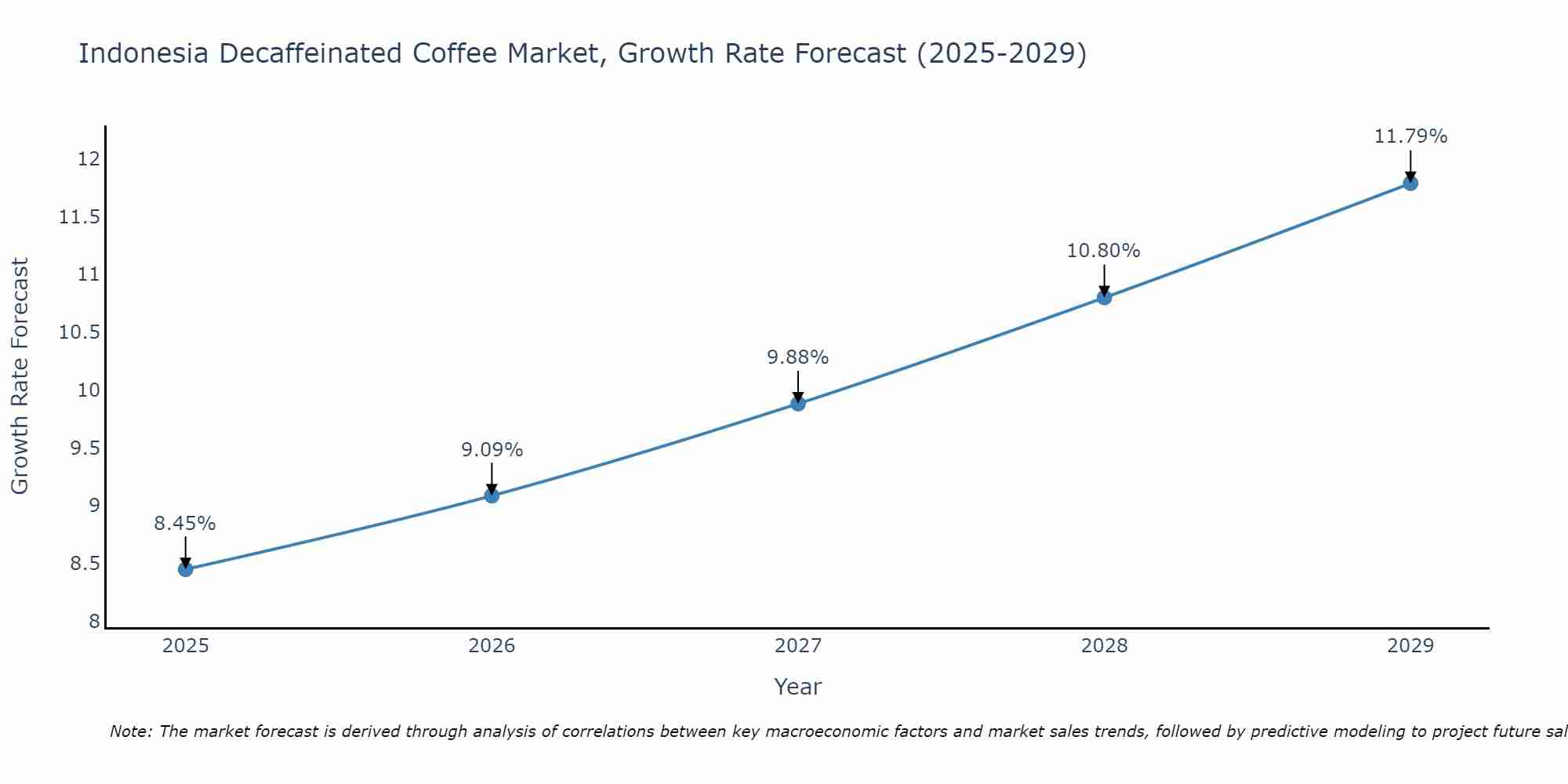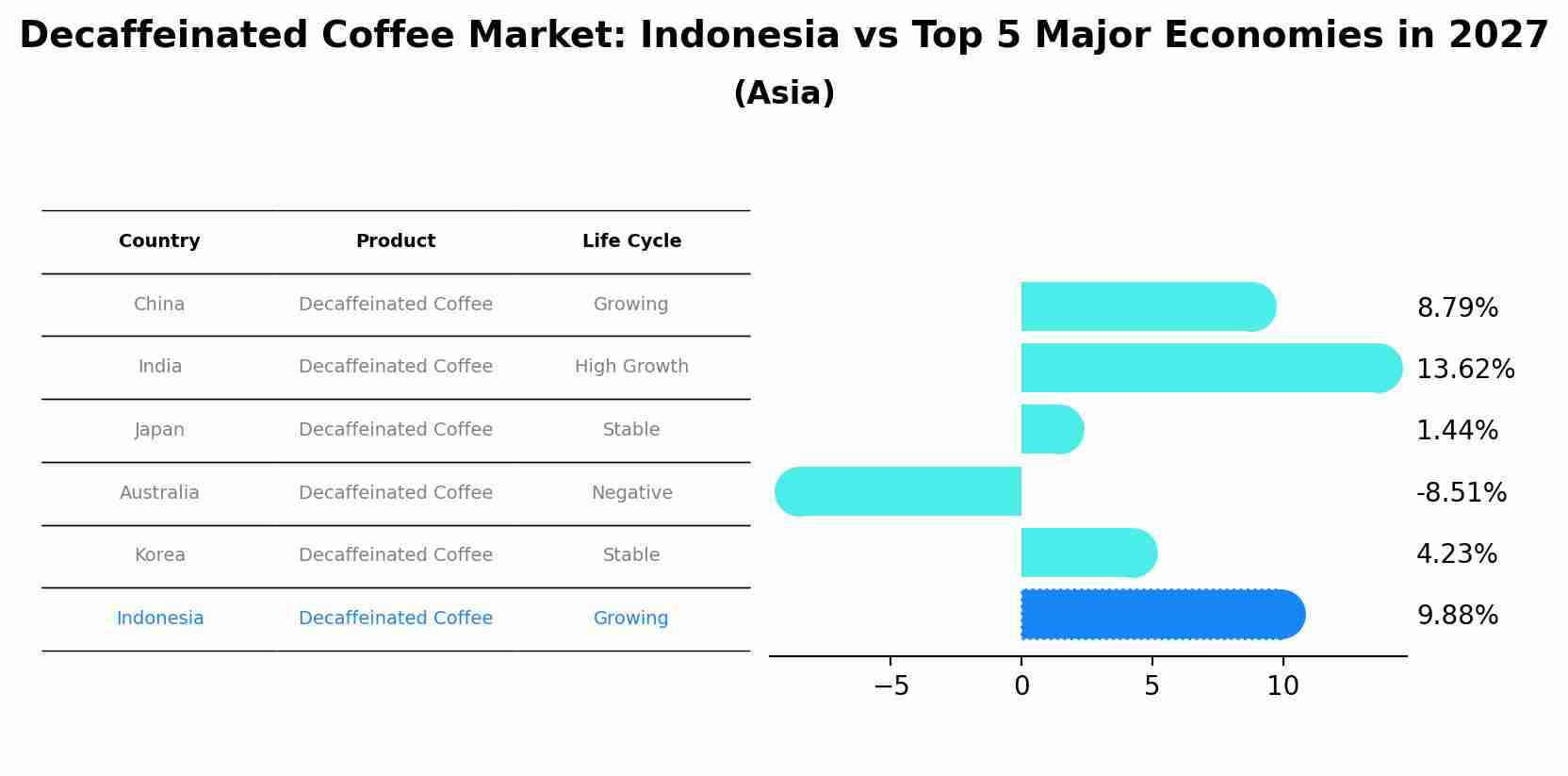Indonesia Decaffeinated Coffee Market | Forecast, Companies, Share, Analysis, Size, Growth, Trends, Industry, Revenue, COVID-19 IMPACT & Value
| Product Code: ETC177407 | Publication Date: Jul 2023 | Updated Date: Apr 2025 | Product Type: Market Research Report | |
| Publisher: 6Wresearch | No. of Pages: 70 | No. of Figures: 35 | No. of Tables: 5 | |
Indonesia Decaffeinated Coffee Market Size Growth Rate
The Indonesia Decaffeinated Coffee Market is poised for steady growth rate improvements from 2025 to 2029. Commencing at 8.45% in 2025, growth builds up to 11.79% by 2029.

Decaffeinated Coffee Market: Indonesia vs Top 5 Major Economies in 2027 (Asia)
The Decaffeinated Coffee market in Indonesia is projected to grow at a growing growth rate of 9.88% by 2027, highlighting the country's increasing focus on advanced technologies within the Asia region, where China holds the dominant position, followed closely by India, Japan, Australia and South Korea, shaping overall regional demand.

Indonesia Decaffeinated Coffee Market Synopsis
Indonesia is the fourth-largest producer of coffee, producing around 350,000 tons annually. Decaffeinated coffee production from Indonesia has seen a steady growth in recent years due to its increasing popularity among consumers. The Indonesia decaffeinated coffee market was valued at USD XX million in 2020 and is expected to reach USD xx million by 2026, registering a CAGR of xx % during 2021?2026 (forecast period).
Market Trends
The demand for organic and natural decaf coffees has been on the rise due to their health benefits over other caffeinated beverages. This trend has encouraged many manufacturers to launch new product lines with organic certification. Additionally, rising concerns about harmful effects caused by caffeine consumption have also propelled the demand for decaffeinated coffees in Indonesia. Moreover, continuous innovations such as flavored decaf coffee are driving consumer interest further as they enhance taste without compromising on their health benefits.
Market Drivers
Increasing global awareness of healthy lifestyle trends is one of the major drivers propelling growth in the Indonesia decaffeniated coffee market. Furthermore, rising disposable income levels coupled with growing urbanization have enabled customers to opt for premium products that provide higher value than regular ones; this factor bodes well for industry players operating within this space. Moreover, changing food habits among young consumers towards healthier options such as plant-based alternatives offer lucrative opportunities for industry players aiming to capitalize on them in order to increase their revenues significantly over time.
COVID-19 Impact on the Market
The outbreak of the COVID-19 pandemic has had a major impact on the Indonesia decaffeinated coffee market, with widespread disruption to production and supply chains. The closure of borders and restrictions on international travel have made it difficult for exporters to access raw materials, resulting in a decrease in exports. Additionally, demand from consumers has decreased as people are spending less due to economic uncertainty caused by the pandemic.
Challenges of the Market
One major challenge facing producers is sourcing decaffeinated coffee beans that meet quality standards while also being affordable enough for mass production. Another challenge is competing with neighboring countries such as Vietnam which have lower labor costs and offer competitively priced products. Lastly, there are environmental considerations related to water conservation during washing processes used for decaffeination that need to be taken into account when producing this product sustainably.
Industry Key Players
Some key players in Indonesia decaffeinated coffee market include JDE (JAVA Decaf Espresso), Kopi Kalimantan (Kalimantan Coffee), Santoscoffee Co., Indocafe (Indonesia Caf?) and Toraja Coffee Group (TCG). Other local companies that produce decaffed coffees include Blossom Coffees and PT Toarco Jaya Agung, among others.
Key Highlights of the Report:
- Indonesia Decaffeinated Coffee Market Outlook
- Market Size of Indonesia Decaffeinated Coffee Market, 2023
- Forecast of Indonesia Decaffeinated Coffee Market, 2030
- Historical Data and Forecast of Indonesia Decaffeinated Coffee Revenues & Volume for the Period 2020-2030
- Indonesia Decaffeinated Coffee Market Trend Evolution
- Indonesia Decaffeinated Coffee Market Drivers and Challenges
- Indonesia Decaffeinated Coffee Price Trends
- Indonesia Decaffeinated Coffee Porter's Five Forces
- Indonesia Decaffeinated Coffee Industry Life Cycle
- Historical Data and Forecast of Indonesia Decaffeinated Coffee Market Revenues & Volume By Product for the Period 2020-2030
- Historical Data and Forecast of Indonesia Decaffeinated Coffee Market Revenues & Volume By Roasted for the Period 2020-2030
- Historical Data and Forecast of Indonesia Decaffeinated Coffee Market Revenues & Volume By Raw for the Period 2020-2030
- Historical Data and Forecast of Indonesia Decaffeinated Coffee Market Revenues & Volume By Species for the Period 2020-2030
- Historical Data and Forecast of Indonesia Decaffeinated Coffee Market Revenues & Volume By Arabica for the Period 2020-2030
- Historical Data and Forecast of Indonesia Decaffeinated Coffee Market Revenues & Volume By Robusta for the Period 2020-2030
- Historical Data and Forecast of Indonesia Decaffeinated Coffee Market Revenues & Volume By Distribution Channel for the Period 2020-2030
- Historical Data and Forecast of Indonesia Decaffeinated Coffee Market Revenues & Volume By Online for the Period 2020-2030
- Historical Data and Forecast of Indonesia Decaffeinated Coffee Market Revenues & Volume By Offline for the Period 2020-2030
- Indonesia Decaffeinated Coffee Import Export Trade Statistics
- Market Opportunity Assessment By Product
- Market Opportunity Assessment By Species
- Market Opportunity Assessment By Distribution Channel
- Indonesia Decaffeinated Coffee Top Companies Market Share
- Indonesia Decaffeinated Coffee Competitive Benchmarking By Technical and Operational Parameters
- Indonesia Decaffeinated Coffee Company Profiles
- Indonesia Decaffeinated Coffee Key Strategic Recommendations
Frequently Asked Questions About the Market Study (FAQs):
1 Executive Summary |
2 Introduction |
2.1 Key Highlights of the Report |
2.2 Report Description |
2.3 Market Scope & Segmentation |
2.4 Research Methodology |
2.5 Assumptions |
3 Indonesia Decaffeinated Coffee Market Overview |
3.1 Indonesia Country Macro Economic Indicators |
3.2 Indonesia Decaffeinated Coffee Market Revenues & Volume, 2020 & 2030F |
3.3 Indonesia Decaffeinated Coffee Market - Industry Life Cycle |
3.4 Indonesia Decaffeinated Coffee Market - Porter's Five Forces |
3.5 Indonesia Decaffeinated Coffee Market Revenues & Volume Share, By Product, 2020 & 2030F |
3.6 Indonesia Decaffeinated Coffee Market Revenues & Volume Share, By Species , 2020 & 2030F |
3.7 Indonesia Decaffeinated Coffee Market Revenues & Volume Share, By Distribution Channel, 2020 & 2030F |
4 Indonesia Decaffeinated Coffee Market Dynamics |
4.1 Impact Analysis |
4.2 Market Drivers |
4.3 Market Restraints |
5 Indonesia Decaffeinated Coffee Market Trends |
6 Indonesia Decaffeinated Coffee Market, By Types |
6.1 Indonesia Decaffeinated Coffee Market, By Product |
6.1.1 Overview and Analysis |
6.1.2 Indonesia Decaffeinated Coffee Market Revenues & Volume, By Product, 2020-2030F |
6.1.3 Indonesia Decaffeinated Coffee Market Revenues & Volume, By Roasted, 2020-2030F |
6.1.4 Indonesia Decaffeinated Coffee Market Revenues & Volume, By Raw, 2020-2030F |
6.2 Indonesia Decaffeinated Coffee Market, By Species |
6.2.1 Overview and Analysis |
6.2.2 Indonesia Decaffeinated Coffee Market Revenues & Volume, By Arabica, 2020-2030F |
6.2.3 Indonesia Decaffeinated Coffee Market Revenues & Volume, By Robusta, 2020-2030F |
6.3 Indonesia Decaffeinated Coffee Market, By Distribution Channel |
6.3.1 Overview and Analysis |
6.3.2 Indonesia Decaffeinated Coffee Market Revenues & Volume, By Online, 2020-2030F |
6.3.3 Indonesia Decaffeinated Coffee Market Revenues & Volume, By Offline, 2020-2030F |
7 Indonesia Decaffeinated Coffee Market Import-Export Trade Statistics |
7.1 Indonesia Decaffeinated Coffee Market Export to Major Countries |
7.2 Indonesia Decaffeinated Coffee Market Imports from Major Countries |
8 Indonesia Decaffeinated Coffee Market Key Performance Indicators |
9 Indonesia Decaffeinated Coffee Market - Opportunity Assessment |
9.1 Indonesia Decaffeinated Coffee Market Opportunity Assessment, By Product, 2020 & 2030F |
9.2 Indonesia Decaffeinated Coffee Market Opportunity Assessment, By Species , 2020 & 2030F |
9.3 Indonesia Decaffeinated Coffee Market Opportunity Assessment, By Distribution Channel, 2020 & 2030F |
10 Indonesia Decaffeinated Coffee Market - Competitive Landscape |
10.1 Indonesia Decaffeinated Coffee Market Revenue Share, By Companies, 2023 |
10.2 Indonesia Decaffeinated Coffee Market Competitive Benchmarking, By Operating and Technical Parameters |
11 Company Profiles |
12 Recommendations |
13 Disclaimer |
- Single User License$ 1,995
- Department License$ 2,400
- Site License$ 3,120
- Global License$ 3,795
Search
Related Reports
- Portugal Electronic Document Management Market (2025-2031) | Strategy, Consumer Insights, Analysis, Investment Trends, Opportunities, Growth, Size, Share, Industry, Revenue, Segments, Value, Segmentation, Supply, Forecast, Restraints, Outlook, Competition, Drivers, Trends, Demand, Pricing Analysis, Competitive, Strategic Insights, Companies, Challenges
- France Electronic Document Management Market (2025-2031) | Strategy, Consumer Insights, Analysis, Investment Trends, Opportunities, Growth, Size, Share, Industry, Revenue, Segments, Value, Segmentation, Supply, Forecast, Restraints, Outlook, Competition, Drivers, Trends, Demand, Pricing Analysis, Competitive, Strategic Insights, Companies, Challenges
- Portugal Occupational Health & Safety Services Market (2025-2031) | Strategy, Consumer Insights, Analysis, Investment Trends, Opportunities, Growth, Size, Share, Industry, Revenue, Segments, Value, Segmentation, Supply, Forecast, Restraints, Outlook, Competition, Drivers, Trends, Demand, Pricing Analysis, Competitive, Strategic Insights, Companies, Challenges
- Netherlands Occupational Health and Safety Services Market (2025-2031) | Strategy, Consumer Insights, Analysis, Investment Trends, Opportunities, Growth, Size, Share, Industry, Revenue, Segments, Value, Segmentation, Supply, Forecast, Restraints, Outlook, Competition, Drivers, Trends, Demand, Pricing Analysis, Competitive, Strategic Insights, Companies, Challenges
- Belgium and Luxembourg Facility Management Market (2025-2031) | Strategy, Consumer Insights, Analysis, Investment Trends, Opportunities, Growth, Size, Share, Industry, Revenue, Segments, Value, Segmentation, Supply, Forecast, Restraints, Outlook, Competition, Drivers, Trends, Demand, Pricing Analysis, Competitive, Strategic Insights, Companies, Challenges
- Russia Women Intimate Apparel Market (2025-2031) | Strategy, Consumer Insights, Analysis, Investment Trends, Opportunities, Growth, Size, Share, Industry, Revenue, Segments, Value, Segmentation, Supply, Forecast, Restraints, Outlook, Competition, Drivers, Trends, Demand, Pricing Analysis, Competitive, Strategic Insights, Companies, Challenges
- Africa Chocolate Market (2025-2031) | Size, Share, Trends, Growth, Revenue, Analysis, Forecast, industry & Outlook
- Global Hydroxychloroquine And Chloroquine Market (2025-2031) | Industry, Trends, Size, Outlook, Growth, Value, Companies, Revenue, Analysis, Share, Forecast
- Saudi Arabia Plant Maintenance Market (2025-2031) | Industry, Size, Growth, Revenue, Value, Companies, Forecast, Analysis, Share & Trends
- Taiwan Electric Truck Market (2025-2031) | Outlook, Industry, Revenue, Size, Forecast, Growth, Analysis, Share, Companies, Value & Trends
Industry Events and Analyst Meet
Our Clients
Whitepaper
- Middle East & Africa Commercial Security Market Click here to view more.
- Middle East & Africa Fire Safety Systems & Equipment Market Click here to view more.
- GCC Drone Market Click here to view more.
- Middle East Lighting Fixture Market Click here to view more.
- GCC Physical & Perimeter Security Market Click here to view more.
6WResearch In News
- Doha a strategic location for EV manufacturing hub: IPA Qatar
- Demand for luxury TVs surging in the GCC, says Samsung
- Empowering Growth: The Thriving Journey of Bangladesh’s Cable Industry
- Demand for luxury TVs surging in the GCC, says Samsung
- Video call with a traditional healer? Once unthinkable, it’s now common in South Africa
- Intelligent Buildings To Smooth GCC’s Path To Net Zero













